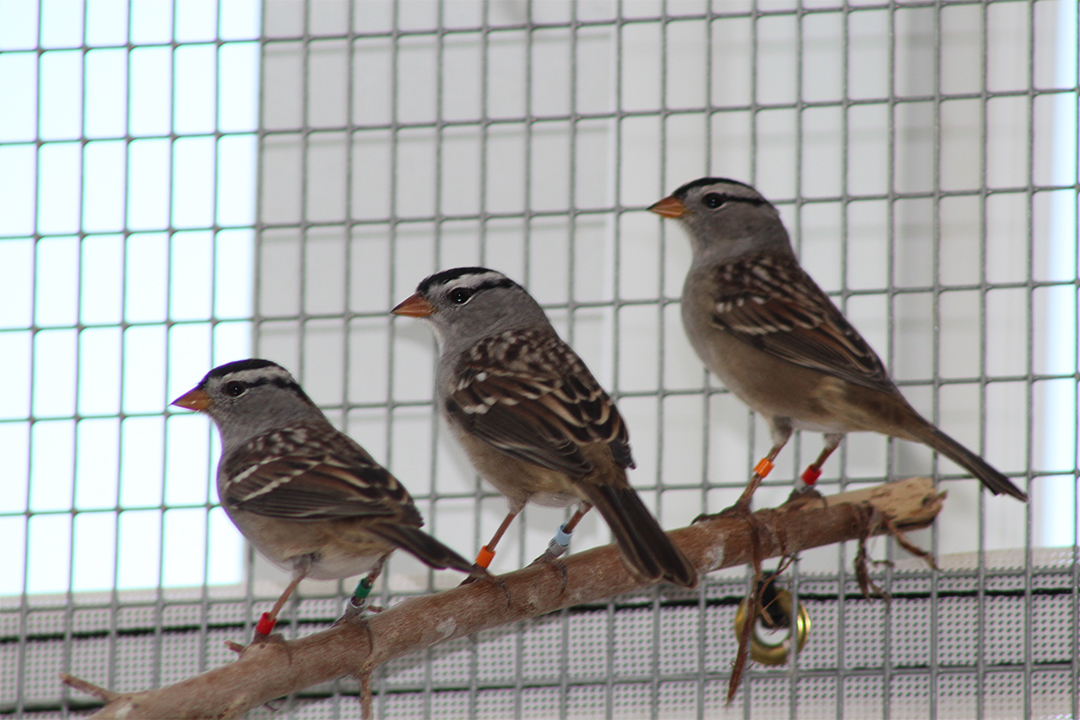Our initial shock at seeing the worms turns into concern: almost a third of the birds in our study have already had these worms in their body cavity and air sacs.
We're all asking the same question: How are these parasites affecting the sparrows' health?
Our team is the first group to work in the University of Saskatchewan's new Facility for Applied Avian Research (FAAR), which opened in May 2016. This particular project, led by Dr. Christy Morrissey and postdoctoral research fellow Dr. Margaret Eng, is investigating the effects of low-dose neonicotinoid and organophosphate insecticides on the migration of white-crowned sparrows.
I was part of their research team for the summer, and now, as their project winds down, I have yet another project — identifying these white worms that have been found in so many of our study's birds.
In fact, each of the three wild bird species that were housed in the new, high-tech building brought along their own complement of worms, protozoa, feather lice or other parasites.
"Of course we know wild birds often pick up parasites, and we don't normally treat them before bringing them into captivity," says Morrissey, an associate professor in the university's Department of Biology and a faculty member in the U of S School of Environment and Sustainability. She's also the director of FAAR, which is ideally set up for this type of experiment since its layout minimizes contamination between bird species.
As well, the design of FAAR allows birds to behave somewhat normally to ensure the best data can be gathered.
"It's hard to get indoor space that's quiet. A lot of the animal facilities on campus are too noisy with a lot of activity, and wild birds are very sensitive to this. There's also risk of contamination between wild and domestic species — like having chickens or domestic fowl near wild birds — so you can't really hold them in the same places," says Morrissey.
Morissey explains that the opportunity to dissect birds that have been kept in captivity is a valuable addition to researchers' ecotoxicology studies.
"This [dissection] is usually an important part of the experiment because we're not only interested in measuring behavioural parameters of the living birds, but we are also interested in changes that happen at the organ level that otherwise can't be seen."
However Morrissey was surprised at the number of worms present and hadn't encountered these worms before. Since Morrissey promotes a multidisciplinary approach in her lab's research, she encouraged me to connect with experts in parasitology and to investigate further.
"I think that the focus of FAAR is to broaden our understanding of how wild birds work," says Morrissey. "There're a lot of opportunities for different researchers who have an interest in birds to bring them here and to conduct a range of interesting studies."
Brent Wagner, a parasitologist from the Western College of Veterinary Medicine (WCVM), helped me with my investigation of the parasites — sharing his expertise and the parasitology lab in the college's Department of Veterinary Microbiology.
This isn't Wagner's first time collaborating with biologists in wildlife parasite research. Over the years, he and his colleagues have worked closely with members of the Research Group for Arctic Parasitology (RGAP).
"But [their work] primarily [focuses on] mammal's parasites and mammal biology — not so much birds," says Wagner.
After an extensive literature search, neither Wagner nor I could find any mention of these extra-intestinal worms in the white-crowned sparrows. It was surprising because nearly a third of the birds in our study had them, and white-crowned sparrows are a common species in research.
In one case, a bird appeared to be healthy, but more than four per cent of its weight consisted of worms — a potentially significant parasite load in a long-distance migratory species.
As we took a closer look at the parasites, I cleared the worm's tough outer cuticle with lactophenol (a solution of phenol and lactic acid in glycerol) to see its internal structures. I mounted the worms on a slide, and measured their microscopic structural characteristics.
Wagner confirmed the parasites were nematode worms, and even better yet, they had a distinctive "trident" (three-pronged) feature at the anterior end.
After some more digging — including translating the most recent review paper from Portuguese to English — we identified the worms to the Diplotriena genus.
These parasites were distributed evenly among the insecticide treatment groups and had no obvious health effects on the birds, but Morrissey and her research group still need to examine the study's behavioural data to determine if there were any statistical differences.
As Wagner points out, quests to identify uncommon parasites aren't always successful — but he's glad that this one led to concrete results.
"It was a neat little project, and I'm glad that it worked out so well. They don't always work out like this."
Gwen Roy of Edmonton, Alta., is a third-year veterinary student at the Western College of Veterinary Medicine (WCVM) and a wildlife biologist.
